Power Generation
/Since you axed me, I'm gonna essplain it to you.
--Rush Limbaugh
A small part of the Rory Miller workshop a few weeks ago was dedicated to power generation. The simple reason for this is that striking a violent threat without doing damage is a waste of time. If you are already receiving damage, your ability to fight is diminishing as time passes.
Rory is able to pass on some very useful material about power generation in a very short time.
Let me start out by saying I think he did a great job of getting people to think about the importance of power generation to self-defense, and how to improve ones power in a short period of time. Tasked with the same goals I would not have done things much differently. However, I’m dedicated to discovering the highest level of martial arts theory available, so we have some taking apart to do.
Here is what he taught.
The drop step is the most immediate way to generate power.
Press the back heel.
Twist suddenly at the hip (kua).
Keep the whole arm and back loose like throwing a baseball.
These all increase power. When put together they dramatically increase power.
I realized a long time ago that I have way more power than I actually need to fight, from a self-defense point of view what I have to say about power generation is trivial. I suppose the charge of esoteric is a fair description of my opinion.
Rory himself raised the issue of why each of these work. With a better understanding of theory we can improve our results. So here are my explanations.
The drop step is used extensively in African dance and many dance systems, it is also the main strategy taught for punching in Northern Shaolin. It works primarily because it adds the force of falling mass. Rolling an elbow forward on the opponent’s arm while doing a drop step puts at least 100 pounds of force, multiplied by a few inches of gravity, onto the opponent. If the opponent’s structure is compromised already, the movement will likely cause damage. It can also shake up a person who has good structure. The flaw of this technique (all techniques have flaws) is that it is vulnerable to a sweep (or a rotation) while in the air, and tends to be over committed at the moment when it lands, particularly if it misses its target.
The same technique can be done internally, without leaving the ground or committing to one foot, but it takes a long time to train.
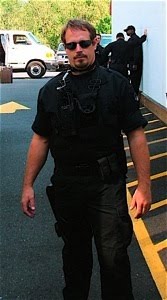
Pressing the back heel is also a major part of Northern Shaolin training. It’s main value is that it backs up projections-- it is what most people do when they jab with a spear to stop from being thrown back by the forward motion of the wild thing they are jabbing. It is not actually a power generating technique. A foot pushing off the ground (whether with the heel or the toe) generates momentum; however, once the momentum is achieved the foot can leave the ground without any loss of force. Pressing the back heel can have another purpose, which is to uproot. In tai chi, we teach people to uproot off of either foot and generally it is the foot which is weighted over the toe which does the uprooting. So even if your back heel is down to root against the forward motion of your opponent, your front foot can still be used to uproot.
Perhaps the full extension of the back heel adds a little momentum (as compared to leaving it up), but that isn’t its main function. No doubt everyone who studies martial arts should learn this technique and build on it, but eventually it should be abandoned. Its flaw is that it combines with the drop step to create an on/off switch. The drop step entails a loss of stability, the pressing of the heel is an attempt to regain it. A superior theory of fighting seeks to eliminate the gap in power created by this transition between “on” and “off.” Some stability is gained in the front/back plane from pressing the heel, but it is lost in the other planes, making the striker vulnerable to rotational force or up/down force. A superior theory of fighting would never strike in a way that sacrifices the six dimensions of power: up/down, left/right, front/back (called liuhe in Chinese). It is preferable to keep the body moving like a rolling, spinning, expanding/shrinking ball which never comes out to a point. Lot’s of Tai Chi guys take this to mean don’t punch, but that isn’t correct, it just means that when you punch, the punch has to be part of a rolling ball.
“Keep the whole arm and back loose, like throwing a baseball” is correct and needs no amending. The more relaxed and empty the movement, the more whole body integration and weight are available for generating force. In class I actually interjected that some people may experience shoulder injuries if they lack protective shoulder muscle. The injury can happen when a person throws the arm with a lot of force while only relaxing halfway. It’s probably best to work this idea gradually. Eventually ones entire body weight can be added to the force through the sequence relax, empty, unify.
Rory actually told us he was uncertain why “Twist the hip suddenly” helps increase power. Here is my explanation. First, rotation in the hip, what in Chinese martial arts we call 'turning the kua,' adds some rotational force so it makes forward force more difficult to stop, deflect or neutralize. Second, the suddenness of the technique is akin to shaking. It loosens the ‘meat’ from the bones and automatically adds fluid weight to the strike. Third, it cuts the body at the waist. This is actually a flaw, but it works! It diminishes structural force from the feet to the hands, however, it increases the moving mass available for the punch. It basically sacrifices the structure of the legs for the weight of the torso. No doubt many people will think I’m crazy for suggesting that loss of structure is a good thing.
Structure can be broken or uprooted-- fluid, dynamic mass can not.
So to summarize: The drop step can be hidden. The heel press isn’t necessary for power but can help with rooting against an on coming force or uprooting a threat’s structure; however a superior fighter will use your structure against you so eventually heel pressing should be discarded. A loose arm increases power if it integrates with the relaxed emptiness of the whole body. The sudden twist of the hip is a flawed technique but has positive effects on power generation anyway.
The big problem with martial arts is that they work. Since most of us will never need to cause massive damage to another person, if we measure martial arts by “effectiveness” they are all a massive waste of time. Most martial arts training will effectively increase power generation as long as you don’t train yourself to pull punches with free sparing, or subordination to the teacher.
While power for power’s sake is a fools errand, the martial arts I teach should give the student more than enough power to overpower a much larger person, or multiple people. But hopefully that will never need to happen. For me, the never ending search for power is just like a dance-- it is simply a happy consequence of freedom-- it is a unique expression of real joy.

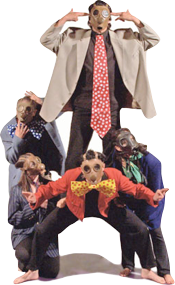 I started taking a Physical Theater class. I haven't been in a class like this for maybe 20 years, but I thought I should test my ideas about the relationship between martial arts and theater training in a more immediate way. The class is called
I started taking a Physical Theater class. I haven't been in a class like this for maybe 20 years, but I thought I should test my ideas about the relationship between martial arts and theater training in a more immediate way. The class is called  Beijing Opera (Jingju) has as its most basic physical training something called "da" literally hitting or striking. The warm ups I learned as a kid studying Northern Shaolin are the very same ones used in Beijing Opera. The stage roles are divided into either martial or civil categories (wu and wen). Extensive weapons training is given to everyone because much of the traditional repertoire involves depicting historic conflicts and battles. Probably the best piece of evidence is the most famous Chinese Opera star of the 20th Century, the female impersonating dan
Beijing Opera (Jingju) has as its most basic physical training something called "da" literally hitting or striking. The warm ups I learned as a kid studying Northern Shaolin are the very same ones used in Beijing Opera. The stage roles are divided into either martial or civil categories (wu and wen). Extensive weapons training is given to everyone because much of the traditional repertoire involves depicting historic conflicts and battles. Probably the best piece of evidence is the most famous Chinese Opera star of the 20th Century, the female impersonating dan  "Mean people" were used for everything from entertaining visiting dignitaries, to weddings, to the most sacred rituals of a region. "Opera Families" were profane outsiders who lived in separate districts or separate villages and yet were paid to entertain and purify--to bring order and expel evil.
"Mean people" were used for everything from entertaining visiting dignitaries, to weddings, to the most sacred rituals of a region. "Opera Families" were profane outsiders who lived in separate districts or separate villages and yet were paid to entertain and purify--to bring order and expel evil.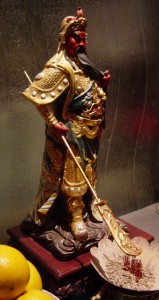 Which brings us back to martial arts. Martial arts were used extensively in these rituals. It seems almost too obvious that the basic physical training for popular and rarefied physical theater in China was in fact martial arts training. Each region had it's own style of gongfu (kung fu) and it's own style of theater (ci). But the basic training was the same. It could be refined for either fighting, performing, or both.
Which brings us back to martial arts. Martial arts were used extensively in these rituals. It seems almost too obvious that the basic physical training for popular and rarefied physical theater in China was in fact martial arts training. Each region had it's own style of gongfu (kung fu) and it's own style of theater (ci). But the basic training was the same. It could be refined for either fighting, performing, or both. A 9 year old student asked me during class the other day if I did any strength training. I did my teacher thing and screwed up one side of my face while bulging out my eye on the other, "No," I replied, "Do you do any strength training?" This kid admitted that he didn't but I could see by the way he looked at the ground that someone had been trying to breed a feeling of deficiency in this kid's head. Now we aren't talking about just any old 9 year old, this kid can walk across the room on his hands and he can do a press handstand from a straddle position on the floor. So I said, "OK, you stand in a low horse stance and I'll put all my weight on your shoulders and you try to lift me up." I leaned down on his shoulders and lifted myself up on to the very tips of my toes so that he had about 150lbs on his shoulders. He then stood up with out even a second thought, lifting me into the air. "That was easy right?" I asked. "You could lift two adults couldn't you?." "Yeah," he said, looking a little brighter. "So you're strong enough already right?" He just looked at me, unsure what to say. "Now you have to figure out how to transfer the force of your legs to your arms. That's what you need to work on." And then we got back to the two-man form we had been working on when he asked the question.
A 9 year old student asked me during class the other day if I did any strength training. I did my teacher thing and screwed up one side of my face while bulging out my eye on the other, "No," I replied, "Do you do any strength training?" This kid admitted that he didn't but I could see by the way he looked at the ground that someone had been trying to breed a feeling of deficiency in this kid's head. Now we aren't talking about just any old 9 year old, this kid can walk across the room on his hands and he can do a press handstand from a straddle position on the floor. So I said, "OK, you stand in a low horse stance and I'll put all my weight on your shoulders and you try to lift me up." I leaned down on his shoulders and lifted myself up on to the very tips of my toes so that he had about 150lbs on his shoulders. He then stood up with out even a second thought, lifting me into the air. "That was easy right?" I asked. "You could lift two adults couldn't you?." "Yeah," he said, looking a little brighter. "So you're strong enough already right?" He just looked at me, unsure what to say. "Now you have to figure out how to transfer the force of your legs to your arms. That's what you need to work on." And then we got back to the two-man form we had been working on when he asked the question.
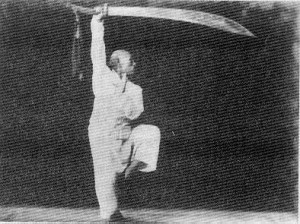 And don't get me started on core strength.... OK, it's too late. Core strength is just a marketing scheme, like Green architectural-design-dog-walking-nanny services. It just sounds good or something. It plays on peoples feelings of insecurity and guilt. There is no core that needs strengthening to begin with, but even if such a core existed, the market is saturated. Every type of movement training from Yoga to tiny-tot-tap-dancing now claims to be good for your "core."
And don't get me started on core strength.... OK, it's too late. Core strength is just a marketing scheme, like Green architectural-design-dog-walking-nanny services. It just sounds good or something. It plays on peoples feelings of insecurity and guilt. There is no core that needs strengthening to begin with, but even if such a core existed, the market is saturated. Every type of movement training from Yoga to tiny-tot-tap-dancing now claims to be good for your "core."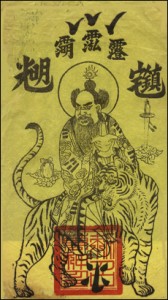 I have written elsewhere about martial arts forms being an
I have written elsewhere about martial arts forms being an  Confucianism is founded on the idea that we inherit a great deal from our ancestors, including body, culture, and circumstance. We also, to some extent, inherit our will, our intentions, and our goals. The Confucian project is predicated on the idea that we have a duty to carryout and comprehend our ancestors' intentions in a way which is coherent with our own circumstance and experiences. In practice, it is entirely possible that we have two ancestors who died with conflicting goals, or an ancestor who died with an unfulfilled desire, like unrequited love, or an ancestor who wished and plotted to kill us. Our dead ancestors have become spirits whose intentions linger on in us to some extent in our habits and our reactions to stress. It is the central purpose of Confucianism to resolve these conflicts and lingering feelings of distress through a continuous process of self-reflection and upright conduct--so that we may leave a better world for our descendants. The metaphor is fundamentally one of exorcism. We empty ourselves of our own agenda so that we might consider the true will of our ancestors (inviting the spirits), then we take that understanding and transform it into action (dispersion and resolution). Finally we leave our descendants with open ended possibilities, support, and clarity of purpose (harmony, rectification, unity).
Confucianism is founded on the idea that we inherit a great deal from our ancestors, including body, culture, and circumstance. We also, to some extent, inherit our will, our intentions, and our goals. The Confucian project is predicated on the idea that we have a duty to carryout and comprehend our ancestors' intentions in a way which is coherent with our own circumstance and experiences. In practice, it is entirely possible that we have two ancestors who died with conflicting goals, or an ancestor who died with an unfulfilled desire, like unrequited love, or an ancestor who wished and plotted to kill us. Our dead ancestors have become spirits whose intentions linger on in us to some extent in our habits and our reactions to stress. It is the central purpose of Confucianism to resolve these conflicts and lingering feelings of distress through a continuous process of self-reflection and upright conduct--so that we may leave a better world for our descendants. The metaphor is fundamentally one of exorcism. We empty ourselves of our own agenda so that we might consider the true will of our ancestors (inviting the spirits), then we take that understanding and transform it into action (dispersion and resolution). Finally we leave our descendants with open ended possibilities, support, and clarity of purpose (harmony, rectification, unity).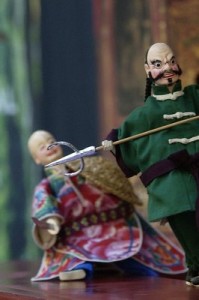 Daoist Meditation takes emptiness as it’s root. All Daoist practices arise from this root of emptiness. The main distinction between an orthodox Daoist exorcism and a less than orthodox exorcism is in fact the ability of the priests to remain empty while invoking and enlisting various potent unseen forces (gods/demons/spirits/ancestors) to preform the ritual on behalf of a living constituency, or the recently dead.
Daoist Meditation takes emptiness as it’s root. All Daoist practices arise from this root of emptiness. The main distinction between an orthodox Daoist exorcism and a less than orthodox exorcism is in fact the ability of the priests to remain empty while invoking and enlisting various potent unseen forces (gods/demons/spirits/ancestors) to preform the ritual on behalf of a living constituency, or the recently dead.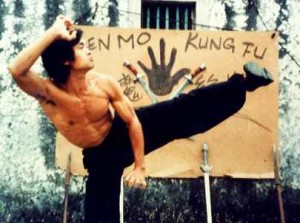 In China, the traveling theater functioned as a subversive organizing tool and a way to hide martial arts training. It was a religious devotional act, watched by the gods (they would literally carry the statues of the gods out of the temples to watch the performances), it was sometimes a ritual exorcism too. The theater was the source of most people's knowledge of history, and it's characters were both gods and heroic ancestors.
In China, the traveling theater functioned as a subversive organizing tool and a way to hide martial arts training. It was a religious devotional act, watched by the gods (they would literally carry the statues of the gods out of the temples to watch the performances), it was sometimes a ritual exorcism too. The theater was the source of most people's knowledge of history, and it's characters were both gods and heroic ancestors. I'll tell you how. Because I'm doing taijiquan, xingyiquan and Baguazhang. I'm doing internal arts when I do these high kicks. Sure, it looks like Shaolin, but if it wasn't the purest internal practice I can pull off, my muscles would be ripping, my ligament falling off the bone. It's not that it would be impossible to do this kind of practice externally at my age, it's just that the risk of injury is so high, and the healing time for even minor injuries is so long, that I couldn't possibly teach or perform.
I'll tell you how. Because I'm doing taijiquan, xingyiquan and Baguazhang. I'm doing internal arts when I do these high kicks. Sure, it looks like Shaolin, but if it wasn't the purest internal practice I can pull off, my muscles would be ripping, my ligament falling off the bone. It's not that it would be impossible to do this kind of practice externally at my age, it's just that the risk of injury is so high, and the healing time for even minor injuries is so long, that I couldn't possibly teach or perform. presence on the boarder is keeping the peace--yes I can imagine him developing internal arts. He has to practice anyway because he might even see some action if things go badly. But most likely he is going to end up back in his home village, perhaps working on a farm. There is some incentive, but it isn't a very strong one.
presence on the boarder is keeping the peace--yes I can imagine him developing internal arts. He has to practice anyway because he might even see some action if things go badly. But most likely he is going to end up back in his home village, perhaps working on a farm. There is some incentive, but it isn't a very strong one.